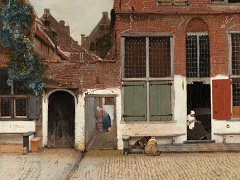The Little Street, 1657 by Johannes Vermeer

Vermeer's The Little Street is one of his most appealing paintings. It is at once picturesque and imbued with quiet dignity. The subject is hardly the street, which is of little consequence
in the painting, but rather the complex of buildings and inhabitants that faces the street. The rows of worn cobblestones which slowly converge towards the vanishing point are essential to create
a reasonable sense of depth and break the stifling flatness of the main facade which dominates the picture plane.
The scene that Vermeer depicts is fully shaded by overhead clouds which would seem to be cumulus clouds lit by the sun shining from the left. The chief pigment of the blue sky is the now defunct
blue azurite, the most common blue found on the palette of 17th-century Dutch painters. Thee clouds are executed with delicate but rapid diagonal brushstrokes of white with small admixtures of
red ochre and azurite.
By the 1660s Vermeer became increasingly aware of the role of natural light for defining space and enhancing the mood of his paintings. Light, in this painting, does not play such an active role.
By the 1660s, moreover, he had perfected a range of techniques for suggesting the various textures of objects, many of which involved using rich impastos of paint. Such textural effects are not
evident in The Little Street despite Vermeer's obvious interest in rendering the varieties of surfaces found in the buildings.




















